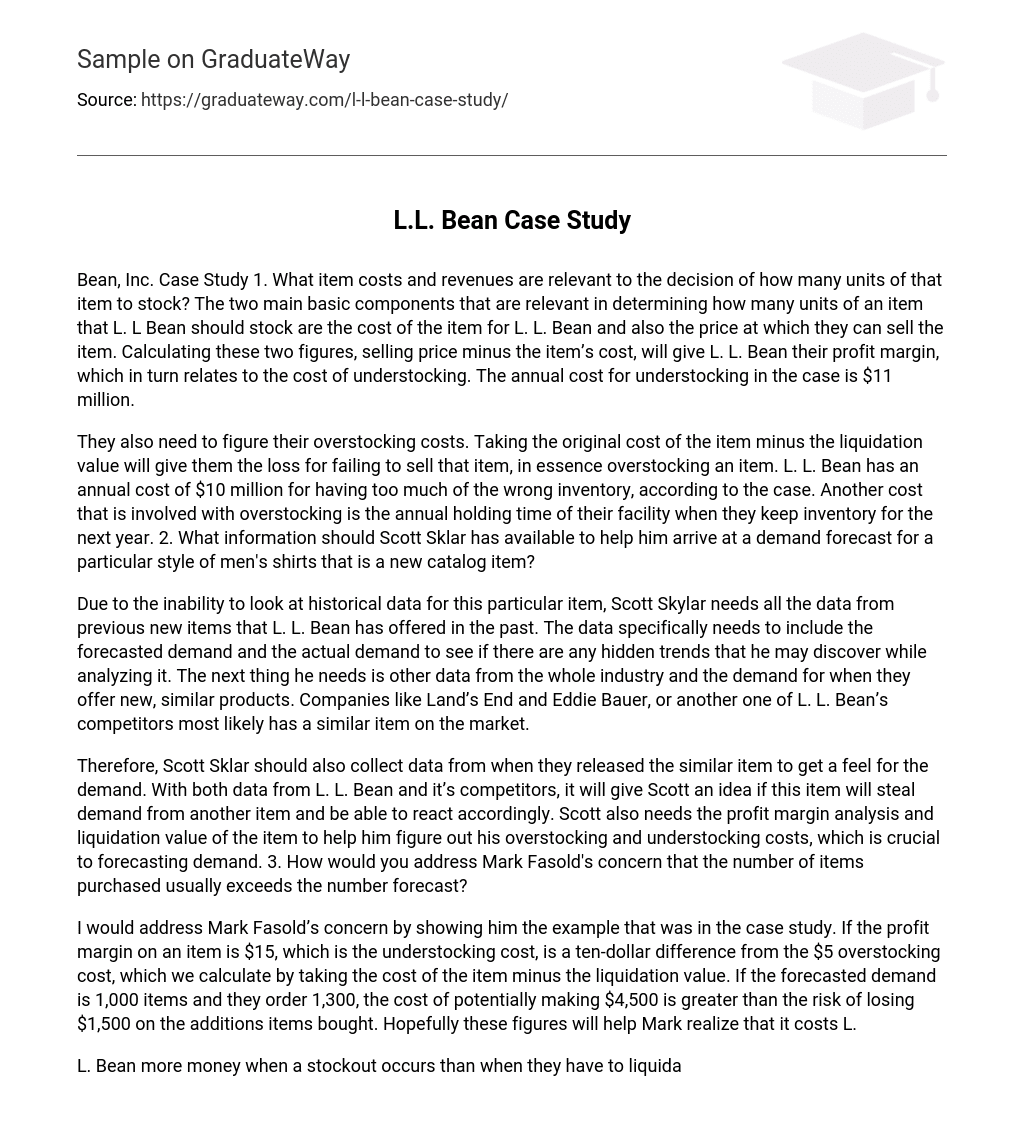Bean, Inc. Case Study 1. What item costs and revenues are relevant to the decision of how many units of that item to stock? The two main basic components that are relevant in determining how many units of an item that L. L Bean should stock are the cost of the item for L. L. Bean and also the price at which they can sell the item. Calculating these two figures, selling price minus the item’s cost, will give L. L. Bean their profit margin, which in turn relates to the cost of understocking. The annual cost for understocking in the case is $11 million.
They also need to figure their overstocking costs. Taking the original cost of the item minus the liquidation value will give them the loss for failing to sell that item, in essence overstocking an item. L. L. Bean has an annual cost of $10 million for having too much of the wrong inventory, according to the case. Another cost that is involved with overstocking is the annual holding time of their facility when they keep inventory for the next year. 2. What information should Scott Sklar has available to help him arrive at a demand forecast for a particular style of men’s shirts that is a new catalog item?
Due to the inability to look at historical data for this particular item, Scott Skylar needs all the data from previous new items that L. L. Bean has offered in the past. The data specifically needs to include the forecasted demand and the actual demand to see if there are any hidden trends that he may discover while analyzing it. The next thing he needs is other data from the whole industry and the demand for when they offer new, similar products. Companies like Land’s End and Eddie Bauer, or another one of L. L. Bean’s competitors most likely has a similar item on the market.
Therefore, Scott Sklar should also collect data from when they released the similar item to get a feel for the demand. With both data from L. L. Bean and it’s competitors, it will give Scott an idea if this item will steal demand from another item and be able to react accordingly. Scott also needs the profit margin analysis and liquidation value of the item to help him figure out his overstocking and understocking costs, which is crucial to forecasting demand. 3. How would you address Mark Fasold’s concern that the number of items purchased usually exceeds the number forecast?
I would address Mark Fasold’s concern by showing him the example that was in the case study. If the profit margin on an item is $15, which is the understocking cost, is a ten-dollar difference from the $5 overstocking cost, which we calculate by taking the cost of the item minus the liquidation value. If the forecasted demand is 1,000 items and they order 1,300, the cost of potentially making $4,500 is greater than the risk of losing $1,500 on the additions items bought. Hopefully these figures will help Mark realize that it costs L.
L. Bean more money when a stockout occurs than when they have to liquidate an item. 4. What should L. L. Bean do to improve its forecasting process? When reading through the case, a major problem that I noticed immediately was that Scott Sklar did not seem as qualified as he could be for forecasting demand. The way he said “some product people”, when talking about his forecasting team rubbed me the wrong way, like he didn’t care. With L. L. Bean’s lead-time being eight to twelve weeks, forecasting is a major issue within the company.
This is why L. L Bean needs to higher someone where his or her job is to only analyze the demand. I believe this will make the demand forecast more accurate, making the company more profitable. The main issue in having to forecast sales so efficiently is having such a lengthy lead-time. This is why L. L. Bean needs to take a page from Toyota’s book and make their suppliers have facilities close to them. This will make L. L Bean’s whole supply-chain more efficient by adding some make-to-order components into their make-to-stock business model.





